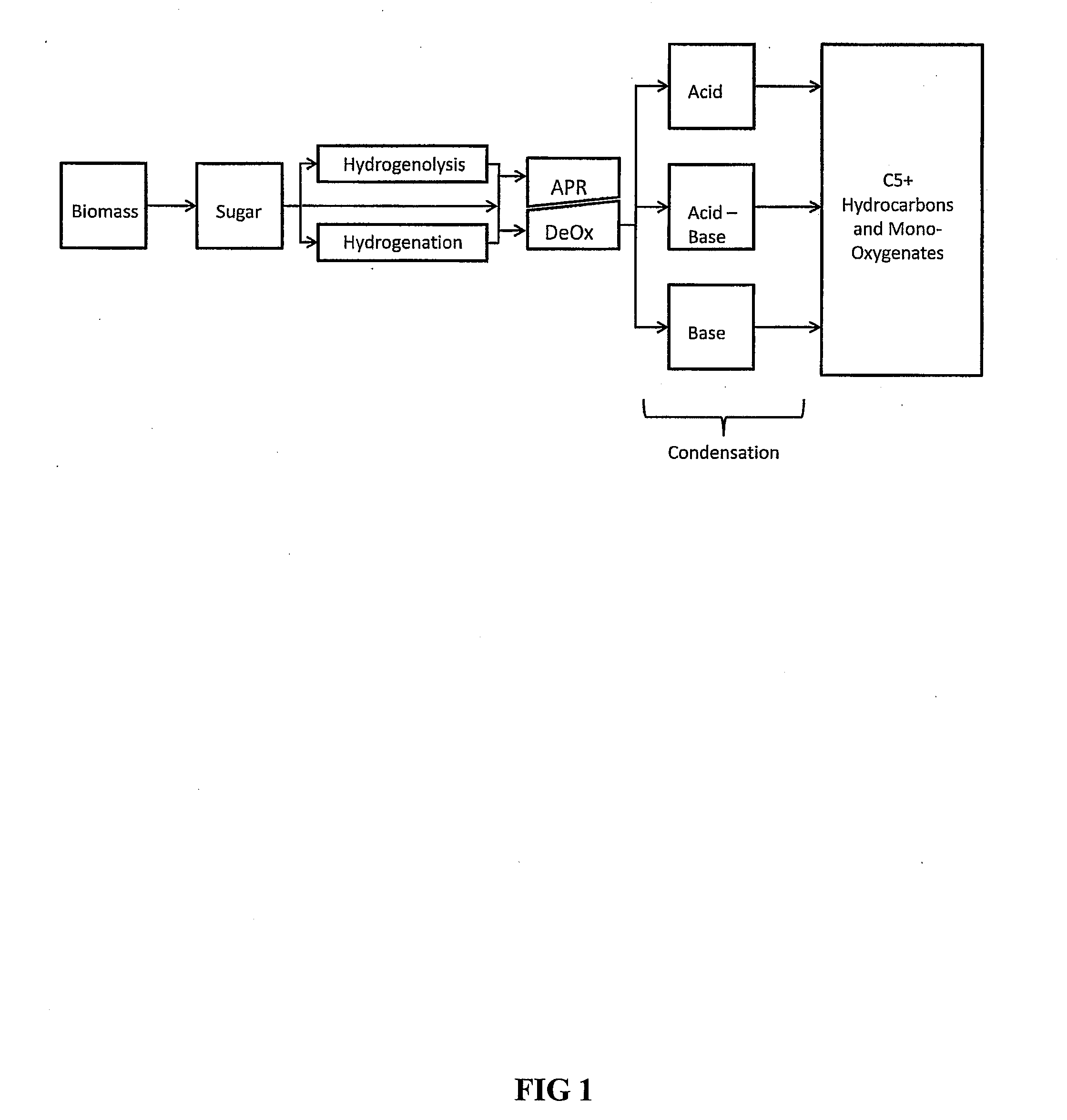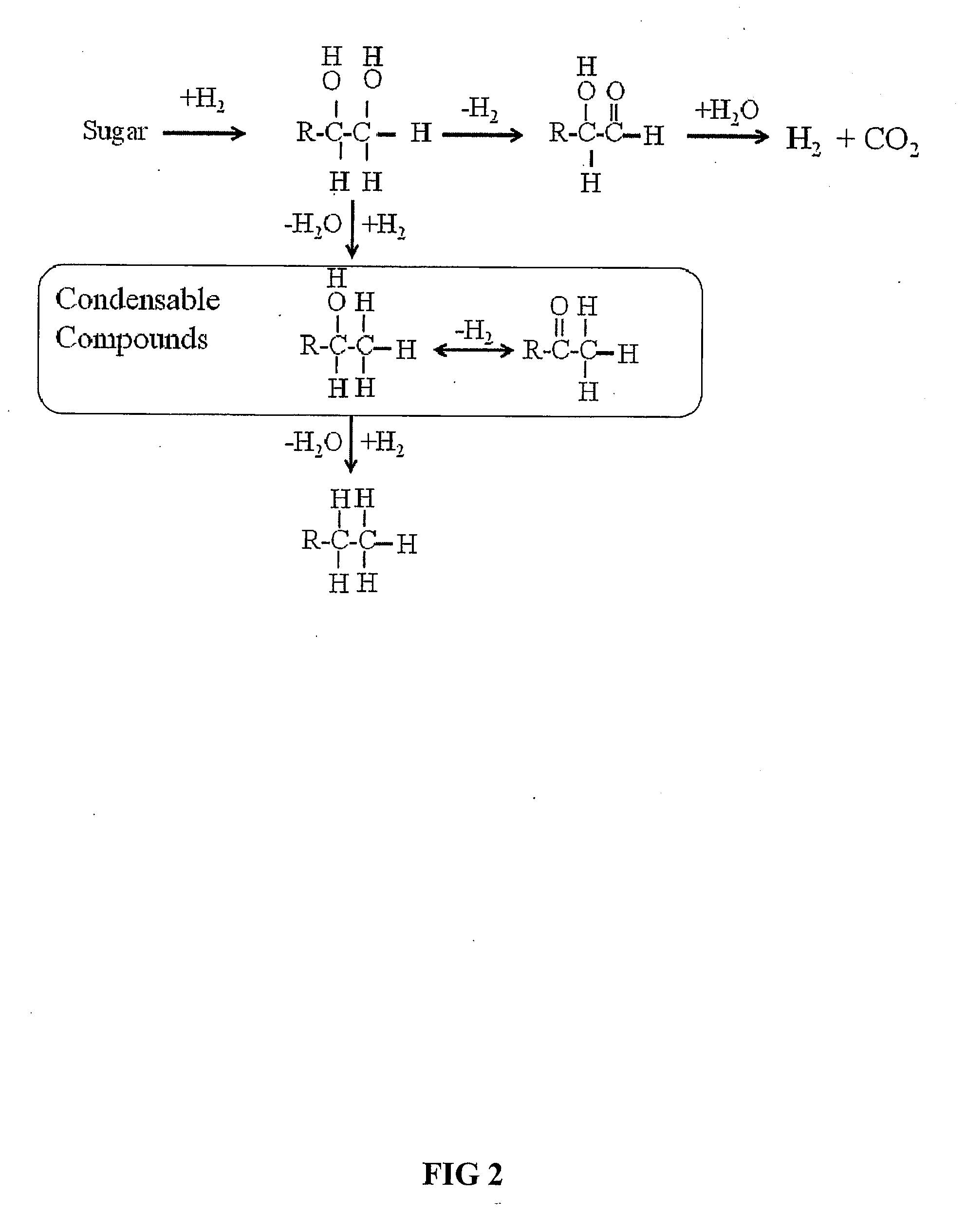Synthesis of liquid fuels and chemicals from oxygenated hydrocarbons
a technology of oxygenated hydrocarbons and liquid fuels, which is applied in the field of synthesis of liquid fuels and chemicals from oxygenated hydrocarbons, can solve the problems of slow development progress of new technologies for producing liquid biofuels, high cost of production of these fuels, and net carbon savings
- Summary
- Abstract
- Description
- Claims
- Application Information
AI Technical Summary
Benefits of technology
Problems solved by technology
Method used
Image
Examples
example 1
[0192]FIG. 8 shows a process diagram illustrating one reactor system useful in practicing the present invention. A feedstock tank 1 acts as a reservoir for holding the feedstock solutions. The feedstock solution is delivered from the feedstock tank 1 to feed pump 3 through feed line 2, where it is then passed through discharge line 4 to preheater 5. The preheater 5 may be a heat exchanger heated by an electrical resistance heater, or any other heat exchanger known in the art. The preheated feed is then passed through line 6 and, in some cases, combined with hydrogen 7 before entering reactor 9 through line 8. One illustration of a potential reactor 9 is set forth in FIG. 11 and more fully described in Example 4 below.
[0193]The temperature of the walls of reactor 9 is maintained by block heaters, 10a, 10b, 10c, and 10d, in this case, electrical resistance heaters. Upon exiting the reactor 9, reaction products enter the reactor outlet line 11 and are cooled to near ambient temperature...
example 2
[0199]FIG. 9 shows a process diagram illustrating another reactor system useful for practicing the present invention. This reactor configuration contains two separate reactors with the capability of operating both reactors in series or operating only the first reactor. In addition, this configuration allows the catalyst in the second reactor to be taken off line and regenerated in situ. After regeneration, the second reactor may be returned to service without impacting the first reactor operation.
[0200]The reactor is similar to the reactor of Example 1, except that the reaction products from reactor product cooler 12 could be routed into the second reactor through line 14 or routed to bypass the second reactor by passing into line 44. When utilizing the second reactor, flow would proceed from line 14 to pressure regulating valve 15. Pressure regulating valve 15 may be used to control the pressure at the outlet of the first reactor. From pressure regulating valve 15 the flow proceeds...
example 3
[0205]FIG. 10 shows a process diagram illustrating a dual feed pump reactor system useful for practicing the present invention. A dual feed pump system is used when the desired mix of feed components would not exist in a single liquid phase. For example, when a mix of 50% by weight 2-pentanol and 50% by weight water is the desired feed, two feed pumps are used, one to deliver 2-pentanol and the other to deliver water. A similar system may also be used to mix feedstock derived from two separate sources, such as a virgin feedstock and an oxygenated hydrocarbon feedstock derived from an effluent stream of the reactor system itself.
[0206]First feedstock tank 1 acts as a reservoir for a first feedstock solution, while second feedstock tank 40 acts as a reservoir for a second feedstock solution. A first feed is delivered from first feedstock tank 1 to first feed pump 3 through first feed line 2. The first feed is then passed through the first feed pump discharge line 4 to combined feed li...
PUM
 Login to View More
Login to View More Abstract
Description
Claims
Application Information
 Login to View More
Login to View More - R&D
- Intellectual Property
- Life Sciences
- Materials
- Tech Scout
- Unparalleled Data Quality
- Higher Quality Content
- 60% Fewer Hallucinations
Browse by: Latest US Patents, China's latest patents, Technical Efficacy Thesaurus, Application Domain, Technology Topic, Popular Technical Reports.
© 2025 PatSnap. All rights reserved.Legal|Privacy policy|Modern Slavery Act Transparency Statement|Sitemap|About US| Contact US: help@patsnap.com



